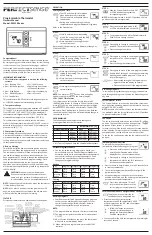
iTHERM TrustSens TM371, TM372
Technical Data
Hauser
51
Measured error digital value (HART):
√(Measured error digital² + Influence of ambient temperature (digital)² + Influence
of supply voltage (digital)²
0.226 °C (0.407 °F)
Measured error analog value (current output):
√(Measured error digital² + Measured error D/A² + Influence of ambient
temperature (digital)² + Influence of ambient temperature (D/A)² + Influence of
supply voltage (digital)² + Influence of supply voltage (D/A)²
0.235 °C (0.423 °F)
Response time
Tests in water at 0.4 m/s (1.3 ft/s), according to IEC 60751; 10 K temperature step
change. t
63
/ t
90
are defined as the time that passes until the instrument output reaches
63% / 90% of the new value.
Response time with heat transfer paste
Protection tube
Shape of tip
Insert
t
63
t
90
6 mm (0.24 in)
Reduced 4.3 mm (0.17 in) x 20 mm (0.79 in)
3 mm (0.12 in)
2.9 s
5.4 s
9 mm (0.35 in)
Straight
6 mm (0.24 in)
9.1 s
17.9 s
Reduced 5.3 mm (0.21 in) x 20 mm (0.79 in)
3 mm (0.12 in)
2.9 s
5.4 s
12.7 mm (¹⁄₂ in)
Straight
6 mm (0.24 in)
10.9 s
24.2 s
Reduced 5.3 mm (0.21 in) x 20 mm (0.79 in)
3 mm (0.12 in)
2.9 s
5.4 s
Reduced 8 mm (0.31 in) x 32 mm (1.26 in)
6 mm (0.24 in)
10.9 s
24.2 s
1)
Between the insert and the protection tube.
Response time without heat transfer paste
Protection tube
Shape of tip
Insert
t
63
t
90
Without
protection tube
-
6 mm (0.24 in)
5.3 s
10.4 s
6 mm (0.24 in)
Reduced 4.3 mm (0.17 in) x 20 mm (0.79 in)
3 mm (0.12 in)
7.4 s
17.3 s
9 mm (0.35 in)
Straight
6 mm (0.24 in)
24.4 s
54.1 s
Reduced 5.3 mm (0.21 in) x 20 mm (0.79 in)
3 mm (0.12 in)
7.4 s
17.3 s
12.7 mm (¹⁄₂ in)
Straight
6 mm (0.24 in)
30.7 s
74.5 s
Reduced 5.3 mm (0.21 in) x 20 mm (0.79 in)
3 mm (0.12 in)
7.4 s
17.3 s
Reduced 8 mm (0.31 in) x 32 mm (1.26 in)
6 mm (0.24 in)
30.7 s
74.5 s
Calibration
Calibration of thermometers
Calibration involves comparing the measured values of a device under test (DUT) with
those of a more precise calibration standard using a defined and reproducible
measurement method. The aim is to determine the deviation of the DUT's measured values
from the true value of the measured variable. Two different methods are used for
thermometers:
• Calibration at fixed-point temperatures, e.g. at the freezing point of water at 0 °C,
• Comparison calibration against a precise reference thermometer.
The thermometer to be calibrated must display the fixed point temperature or the
temperature of the reference thermometer as accurately as possible. Temperature-
controlled calibration baths or special calibration furnaces with homogeneous distribution
of temperature are typically used for thermometer calibrations. The DUT and the reference
thermometer are placed closely together into the bath or furnace at a sufficient depth.
The measurement uncertainty can increase due to heat conduction errors and short
immersion lengths. The existing measurement uncertainty is listed on the individual
calibration certificate.
Summary of Contents for iTHERM TrustSens TM371
Page 2: ......
Page 106: ...www addresses endress com ...
















































